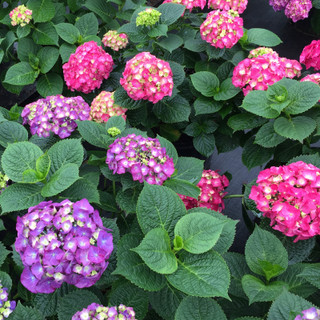
Crape Myrtle
Uses:
- Specimen or Focal Point
- Container Gardens
- Flowering Borders & Hedges
Features:
- Produces Bright Showy Flowers
- Disease Resistant & Heat Tolerant
- Attracts Bees & Birds
Sunlight:
- Full Sun
- 6+ Hours of Direct Sun
Growing Zones:
- 6-10
- What is My Zone?
Crape Myrtle are a deciduous shrub or tree that produces showy summer blooms and boasts attractive bark during the winter. This versatile shrub comes in single or multi trunk varieties. These can tolerate hot and humid conditions and are a popular southern plant.
Why Buy Crape Myrtles Online?
Crape myrtle bushes and trees (Lagerstroemia) are popular in the Southern United States for their prolific summer blooms. These plants are also resilient and easy to grow for people with a brown thumb. Crape myrtles provide great shade and color to any landscape all summer long. Also, more cold hardy varieties have been introduced, which are rated down to growing zone 6!
Growing Zones 6-10
Resilient & Easy To Grow
Blooms During the Summer
Typically Grow in Full Sun
Heat & Drought Tolerant Once Established
About Crape Myrtle

Crepe Myrtle, Crapemyrtle
Tropical and subtropical Asia, India, Northern Australia
Trees, Shrubs
Deciduous
6 - 9
Purple/Lavender, Red/Burgundy, White
Spring, Summer
Erect Multi-trunked
Bees, Butterflies, Hummingbirds
Drought, Heat, Pollution
Deer, Pests, Diseases
How To Use Crape Myrtle In The Garden
Crape myrtles are notable for their glossy foliage, exfoliating bark, and showy flowers that bloom in white, red, pink, or purple throughout the summer, with some varieties continuing until frost. These plants can be cultivated as shrubs or trees, ranging from 2 feet to 30 feet in height, depending on the cultivar and pruning methods.
They can be used as accent plants, deciduous hedges, or planted in rows to create an allée. Their non-invasive root systems make them excellent choices for street trees, as they won't disrupt sidewalks or foundations. Additionally, their year-round interest—from summer blooms to attractive bark in winter—adds aesthetic value to any garden.
Crape Myrtle Care
Crape myrtles require full sun exposure, receiving at least six hours of direct sunlight daily, to maximize blooming potential. They prefer well-draining, slightly acidic soil with a pH between 5.5 and 6.5. Water thoroughly during the first two growing seasons to establish a strong root system; once established, they become relatively drought-tolerant. Apply a light fertilizer monthly in the first year, then twice monthly from spring through summer in subsequent years.
Prune crape myrtles during their dormant winter period before new growth appears. Avoid topping, known as "Crape Murder," which damages the plant's natural form; instead, remove crowded interior or crossing branches to maintain an open center. Compact varieties can thrive in containers with adequate drainage and a high-quality potting mix. In colder climates, protect potted crape myrtles during winter by wrapping the container with frost cloth or burlap.
Learn More About Crape Myrtle Care

Crape Myrtle Companion Plants
Some Crape Myrtle trees can grow 15-25 feet tall. Plants that love shade like hostas and coral bells are great to plant underneath this ornamental tree. If your landscape space does not allow for a full size tree, a dwarf variety paired with smaller types of ornamental shrubs such as hydrangeas or spirea add additional color. Pairing ornamental grasses leading up to Crape Myrtle trees adds a nice foliage interest along walkways or paths.
Growing Crape Myrtles
The common Crape Myrtle is a native of China and Korea with a large number of cultivars. We offer a variety of Crape Myrtles because their noninvasive roots make them great for walkways, driveways or street trees. Resembling a lilac tree and available in dwarf varieties, this tree is disease and pest resistant, as well as heat tolerant. Typically colored white, and multiple shades of red, purple, and pink, this multi stemmed tree attracts bees and birds.
The Best Way to Use Crape Myrtles
Standard single or multi-trunk Crape Myrtles trees can grow 15-25 feet tall with a spread of 6-15 feet. There are also smaller dwarf varieties ranging from 6-8 feet tall with shrub varieties 2-5 feet tall. This deciduous tree has a wide spreading, flat topped, rounded, or even spike shaped open habit. Winter hardy growing in USDA zones 6-9, this plant requires at least 6 hours of full sun each day. Crape Myrtles can grow in a wide range of soils but prefer moist, well-drained areas. Depending on the variety you choose, this versatile plant can be used in so many ways- accent, hedge, specimen, border, shade, containers, or mass planting. Crape myrtles bloom in late spring through summer on new growth, so pruning should be done in winter when they're dormant.
Resilient & Easy To Grow
Grow in a row for flowering borders & hedges
Use dwarf varieties in containers
Available in white, red, purple, or pink
Grow in Full Sun
Heat & Drought Tolerant Once Established
Growing Zones 6-10




























